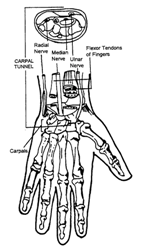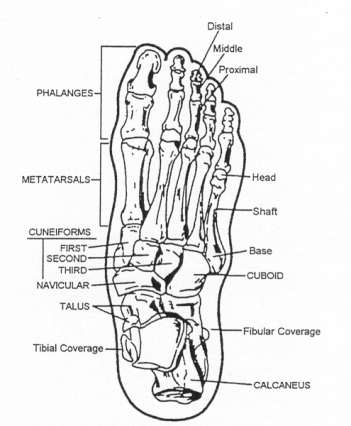|
CORRESPONDENCE
COURSE
U.S. ARMY ACADEMY OF HEALTH SCIENCES
SUBCOURSE MD0577 EDITION 100
THE MUSCULOSKELETAL SYSTEM I
The musculoskeletal system is composed of osseous (bone) tissue and
muscle tissue. Both are essential parts of the complex structure that
is the body.
The skeletal system has a major role in the total structure of the
body, but bones and joints alone cannot produce movement. Together,
skeletal tissue and muscle tissue are important parts of the
functioning of the body as a whole.
----------------------
Length: 49 Pages
Estimated Hours to Complete: 6
Format: PDF file
Size: 1.8 MB
----------------------------
Anyone may take this course. However, to receive credit hours, you
must be officially enrolled and complete an examination furnished by
the Nonresident Instruction Branch at Fort Sam Houston, Texas.
Enrollment is normally limited to Department of Defense personnel.
Others may apply for enrollment, but acceptance is not guaranteed.

The Musculoskeletal System
Distance Learning
Course
49 Pages
Est. 6 Hours
1.8 MB pdf file
Download Now |
|

TABLE OF CONTENTS
INTRODUCTION
1 DISEASES AND DISORDERS OF THE MUSCULOSKELETAL SYSTEM
Section I. The Musculoskeletal System
Section II. Joint Pain
Section III. Specific Musculoskeletal Diseases
Exercises
2 DISEASES AND DISORDERS OF THE FEET
Section I. Skeletal and Muscular Structure of the
Feet.
Section II. Heel Disorders
Section III. Metatarsalgia Disorders
Section IV. Arthritis of the Feet.
Section V. Malformations and Deformities of Feet.
Section VI. Prevention of Foot Problems
Exercises
-------------------------
LESSON 1
DISEASES AND DISORDERS OF THE MUSCULOSKELETAL SYSTEM
Section 1. THE MUSCULOSKELETAL SYSTEM
1-1. INTRODUCTION
The musculoskeletal system is a complex system of
bones, muscles, ligaments, tendons, and other connective tissue. It is
this system that gives the body form and shape. This system is subject
to a variety of diseases some of which are not well understood. As a
medical noncommissioned officer (NCO), you will often need to
distinguish the characteristics of musculoskeletal diseases.
1-2. CAUSES OF DEVIATIONS FROM NORMAL MUSCULOSKELETAL FUNCTIONING
Disease, defects, and trauma are the major causes of
musculoskeletal system malfunction. Diseases such as arthritis,
osteoporosis (imbalance between bone formation and reabsorption), and
tumors interfere with proper musculoskeletal functioning. Other
defects such as cysts and congenital problems can cause
malfunctioning. Trauma to the body such as fractures, sprains,
dislocations, subluxations, and strains also cause musculoskeletal
system dysfunction.
Section II. JOINT PAIN
1-3. TYPES AND EXAMPLES
The skeletal system is made up of many separate bones
held together at joints by flexible connective tissue. The movements
that allow us to change position by moving the bony parts of our
bodies occur at the joints (also called articulations). Joints
are classified by function also taking into account the degree of
movement the joint permits. Classified by function there are these
types of joints: synarthroses (immovable joints),
amphiarthroses (slightly movable joints), and diarthroses
(freely movable joints). Additionally, joints are classified by
connections: fibrous joints (no joint cavity and bones held
together by connective tissue), cartilaqinous joints (no joint
cavity and bones held together by cartilage), and synovial ioints
(joint cavity and bones forming joint are united by accessory
ligaments). Joints are subject to pain that can be classified as
monarticular pain and polyarticular pain.
1-4. MONARTICULAR PAIN
Monarticular pain is pain that occurs in one joint. Causes of
monarticular pain include:
a. Mechanical
Cause. A direct blow to the joint will cause pain. Also,
injuries to other body parts that are close to the joint may cause
pain in the joint.
b.
Osteoarthritis. This is the most common form of arthritis and
is a deterioration of the joint cartilage and the formation of new
bone at the margins and subchondral areas of the joints. Joint pain
is the most common symptom of this condition.
c. Tumors.
A tumor, an overgrowth of tissue, can occur at a joint. The tumor
may be benign or malignant, causing pain in either case.
d. Pyogenic
Cause. Pyogenic refers to a pus-forming infection. It can be
acute (sudden onset) or chronic (ongoing but milder). In either
case, if this occurs
at a joint, there will be pain.
e. Metabolic Cause.
Metabolism refers to the chemical processes taking place in the
body's living tissues, processes needed to maintain life. Increased
production of uric acid and calcium can result in joint pain.
f. Avascular
Necrosis Cause. This refers to the death of tissue due to poor
circulation, this tissue having no blood vessels
g. Neuropathic
Cause. Joint pain can be associated with nervous system disease.
1-5. POLYARTICULAR
PAIN
Here, pain occurs in
several joints. Types of polyarticular pain include acute
polyarticular pain and subacute pain. Conditions in which there is
acute polyarticular pain include rheumatoid arthritis, systemic lupus
erythematous, metabolic-caused joint pain, viral infection, and
rheumatic fever.
a. Rheumatoid
Arthritis. In this chronic, systemic, inflammatory disease, the
joints are affected. Initially, the affected joints may only feel
stiff when the individual gets up in the morning. Later, joints
become painful and tender, especially joints of the wrists, knees,
elbows, and ankles.
b. Systemic Lupus
Erythematous. This is an inflammatory infectious tissue disease that
bears some similarities to rheumatoid arthritis. Joint pain and
stiffness are the first and most common symptoms of the disease.
c. Metabolic Caused
Joint Pain. These disorders can produce monarticular and
polyarticular pain.
d. Viral Infection
Process. Diseases in this category range from the common cold and
influenza to chicken pox, German measles, and herpes simplex. All
are viral infections.
e. Rheumatic Fever.
This fever characteristically follows a streptococcal infection. A
common complaint among many patients is migratory joint pain.
1-6. SUBACUTE PAIN
This type of pain is
chronic but does not have the characteristics of deformity of the area
with the exception that there is swelling. Subacute pain can be a
symptom of rheumatoid arthritis, systemic lupus erythematous, and
metabolic-caused joint pain. Subacute pain can also be characteristic
of ankylosing spondylitis, a progressive chronic disease of the small
vertebral joints of the spine.
From The
Musculoskeletal System |


